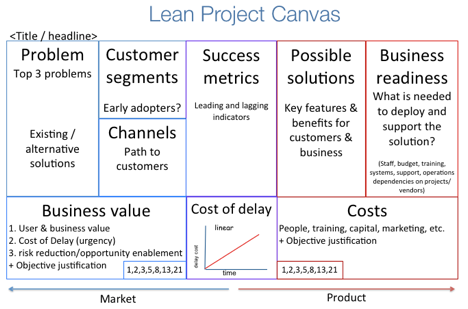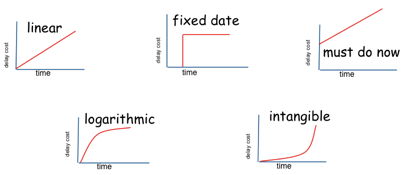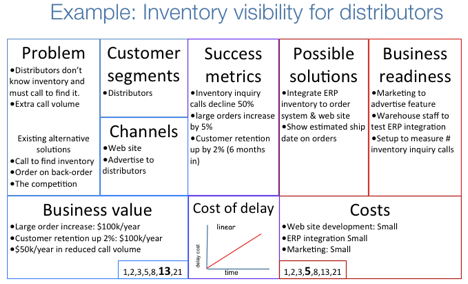I Think We Should Do «another fancy practice»
Problem: Many organizations lack a rigorous way to prioritize and manage their portfolio of projects. They may be lean & agile at the team level, but they aren’t applying the same principles to the portfolio. Stakeholders often battle each other to prioritize their pet projects, and in the end, projects are prioritized based on the HiPPO method: Highest Paid Person’s Opinion.
Lean canvas to the rescue! Lean Canvas is useful and simple tool for weighing different business plans to choose the most promising options. With some modifications, it serves as a great tool for guiding prioritization for your project portfolio. The adaptations we’ve made for this purpose are listed briefly here and described in more detail below.
Lean Canvas is introduced by Ash Maurya in the book Running Lean: Iterate from Plan A to a Plan That Works. It is a single page business model, derived from Alex Osterwalder’s Business Model Canvas, and incorporating Lean Startup principles. The canvas contains sections for the key information required to make a go/no-go decision on starting up a new venture. It is aimed primarily at technology and web startups, but can be applied to most type of businesses.
The lean canvas is shown below, and is Licensed under Creative Commons-Attribution-Share Alike 3.0 license.

The left half of the canvas contains product-centric attributes, while the right side contains market-centric attributes. The size of each panel indicates the relative importance and constrains the amount of information that can be included. The numbers in each panel indicate Maurya’s recommended order for filling in information.
A few panels warrant some additional description.
Problem
Customer Segments
Key Metrics

The project canvas is designed to be filled in left to right, top to bottom. I’ve switched the market-centric attributes to the left side and product-centric to the right in order to encourage thinking about the problem space before jumping to the solution space.
The panels of the project canvas, where different from Lean Canvas, are further described below.
Success Metrics
This is renamed from key metrics in the lean canvas, I also moved it to the middle since it may include both market and product metrics. Leading and lagging indicators tell us if our solution is succeeding in the market. Leading indicators can tell us in advance if we are succeeding, while lagging indicators tell us after the fact. Lean principle: validated learning. This gives us the “measure” portion of the build-measure-learn loop.
While we prefer objective, measurable indicators, sometimes the right thing to measure isn’t easy to measure.
Possible Solutions
The word possible is important here. We haven’t built the proposed solution yet, so we don’t know if it is, in fact, a solution. The possible solutions may relate to the existing alternative solutions in the Problem panel. We also want to invite other possible solutions, which emphasizes the lean startup principle of validated learning.
Business readiness
This panel replaces the unfair advantage panel in lean canvas, which we found was typically not relevant for projects. Readiness, on the other hand, is often a huge consideration in projects. Projects typically require much more than just development to be ready for customers. Marketing, deployment, operations, support, user training, and maintenance,etc. need to be considered. Good agile teams will often deliver products faster than the rest of the business is able to deploy and operate them!
Cost of Delay
Cost of delay is an important factor in mitigating risk and scheduling projects. As Donald Reinertsen writes, if you measure one thing, measure the cost of delay. This panel provides a visual indicator of urgency via the Cost of Delay profile: how much cost/penalty is incurred (vertical axis) for delivering at a later time (horizontal axis). Kenny Rubin describes several delay profiles as shown below.

Business Value
In the book Agile Software Requirements, Dean Leffingwell describes three components of value as part of the weighted shortest job first (WSJF) ranking model:
User & business value may come from several sources: new business, upsell, customer retention, and operational efficiency.
Tangible estimates of business value are critical to move beyond the HiPPO (highest paid person’s opinion) prioritization method.
Relative point values for business value and cost
Inside the business value and costs panels, there is a sub-panel to indicate the relative business value and relative cost (effort) in the range of “points”. The example shows 1 to 21 using a Fibonacci scale, and other ranges could also be used such as the 100 to 2000 point scale of the agile Business Value Game The business value points may reflect all three of the WSJF components, or each can be estimated separately. A process for arriving at an estimate is described below. It is important to emphasize that the business value is estimated relative to other projects. Cost is estimated separately, and it is also relative to the set of projects being considered.
ROI
Once value and cost are assigned relative point values, the return on investment (ROI) can be easily estimated as value divided by cost. Note that we need to know only the relative value and relative cost of a set of projects to determine the best ROI of the bunch.
An example of a lean project canvas, derived from an actual client’s project canvas is shown below.


Lean Project Canvas by Brad Swanson is licensed under a Creative Commons Attribution-ShareAlike 3.0 Unported License. Based on a work at http://runninglean.co/.
Agile development teams are familiar with relative sizing/estimating using points, often using Planning Poker® or the Team Estimation Game to arrive at a group consensus.
To reach an agreement on the relative business value, I have successfully used the agile42 Business Value Game, which is facilitated much like Planning Poker®. Buy-a-Feature, one of the great Innovation Games®, can also be used, although it requires an estimate of cost/size first, whereas the Business Value Game does not.
A deeper explanation of how I’ve used the Business Value Game to facilitate a group of diverse and often competing stakeholders to arrive at an agreement on value will be the subject of a separate post.
Summary
The lean project canvas is designed to bring rigor to the process of prioritizing a portfolio of projects, while keeping it lean and agile. The adaptations from Maurya’s lean canvas make it more useful for a project versus a business plan. The lean project canvas brings more objective data into the discussion of project priorities. A skilled facilitator can help bring a diverse group of stakeholders to an agreement on project priorities using the lean project canvas and techniques such as the business value game.
Presentation from AgilePalooza and Mile High Agile 2013
Here are my downloadable slides on the Lean Canvas for Portfolio Management as presented at AgilePalooza and Mile High Agile 2013. (1.2 MB PDF file)